Hopi Pueblo Ma’alo Katsina Doll, circa 1930s - C3783G
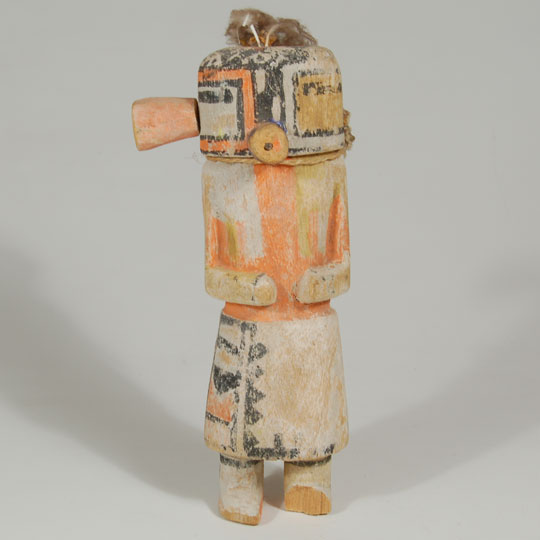 Ma'alo Katsina was one of the most popular of the katsinam in dances around 1900. He was often in the Niman dances along with Hemis, Angak'china and Kuwan Heheya. He usually appeared with Takursh Mana as his sister, dancing in a separate line alongside him. For some reason, he is not often seen in dances today. This is not unusual in that katsinas appear and disappear from time to time.
Ma'alo Katsina was one of the most popular of the katsinam in dances around 1900. He was often in the Niman dances along with Hemis, Angak'china and Kuwan Heheya. He usually appeared with Takursh Mana as his sister, dancing in a separate line alongside him. For some reason, he is not often seen in dances today. This is not unusual in that katsinas appear and disappear from time to time.
San Ildefonso Pueblo Polished Black Bowl signed Than-Moo-Whé - C3771G
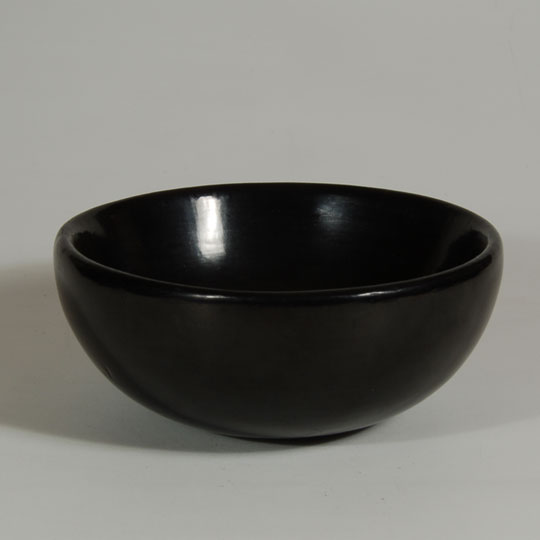 Barbara Gonzales is an excellent potter and an extension of her famous great-grandmother, Maria Martinez, and her grandparents, Adam and Santana Martinez. Her mother, Anita Martinez, was also a potter. Drawing on the traditions of her family, she expanded this tradition by personalizing her pottery with inlaid coral and turquoise on etched black and sienna wares-often inlaid on spider designs which she created in 1973. Early in her career she occasionally made plain black polished pottery, but no longer does so, nor dose any other potter from San Ildefonso.
Barbara Gonzales is an excellent potter and an extension of her famous great-grandmother, Maria Martinez, and her grandparents, Adam and Santana Martinez. Her mother, Anita Martinez, was also a potter. Drawing on the traditions of her family, she expanded this tradition by personalizing her pottery with inlaid coral and turquoise on etched black and sienna wares-often inlaid on spider designs which she created in 1973. Early in her career she occasionally made plain black polished pottery, but no longer does so, nor dose any other potter from San Ildefonso.
Acoma Pueblo Squash Blossom Necklace by Clyde Hunt - C3785E
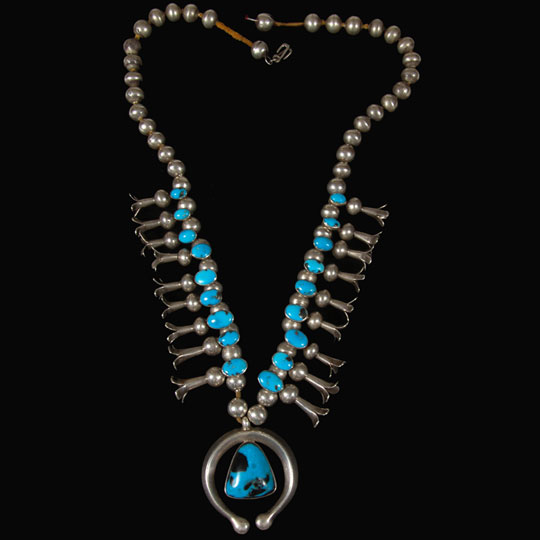 In 1939, Chief Sunny Skies, a Native of Acoma Pueblo, was planning on marrying a woman named Estelle and he made for her a silver and turquoise necklace with beautiful handmade silver beads, eighteen handmade blossoms, each with a beautiful turquoise stone, and a naja with a magnificent turquoise stone in its center. On the back of the naja, he inscribed "To Estelle from Sunny Skies, 1939, Made by Sunny Skies, Wedding Necklace"
In 1939, Chief Sunny Skies, a Native of Acoma Pueblo, was planning on marrying a woman named Estelle and he made for her a silver and turquoise necklace with beautiful handmade silver beads, eighteen handmade blossoms, each with a beautiful turquoise stone, and a naja with a magnificent turquoise stone in its center. On the back of the naja, he inscribed "To Estelle from Sunny Skies, 1939, Made by Sunny Skies, Wedding Necklace"
Historic Ohkay Owingeh (San Juan) Black on Grey Storage Jar - C3783A
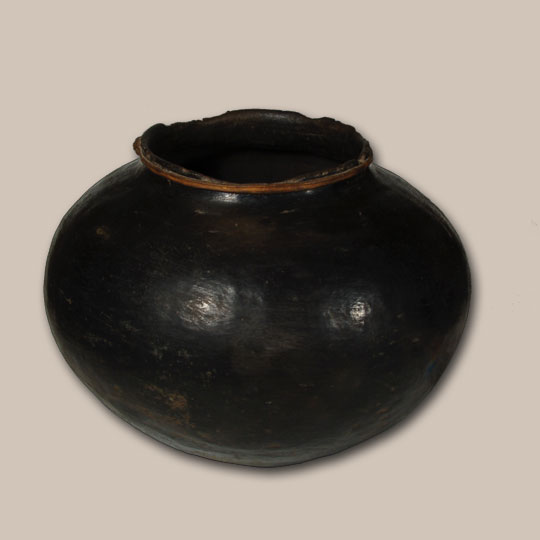 Pottery making at Ohkay Owingeh - San Juan Pueblo almost died out around 1900 except for a few women who made pottery for their own use. There was no market for these rather plain undecorated vessels. It is believed that this jar dates to around 1900 or a little earlier. The upper two-thirds of the jar was slipped with red clay and the lower one-third was left in the natural, un-slipped, tan clay of the full vessel that was stone polished without the addition of red slip.
Pottery making at Ohkay Owingeh - San Juan Pueblo almost died out around 1900 except for a few women who made pottery for their own use. There was no market for these rather plain undecorated vessels. It is believed that this jar dates to around 1900 or a little earlier. The upper two-thirds of the jar was slipped with red clay and the lower one-third was left in the natural, un-slipped, tan clay of the full vessel that was stone polished without the addition of red slip.
Pair of Black Pottery Moccasin-style Candle Holders by Rose Gonzales - C3785D
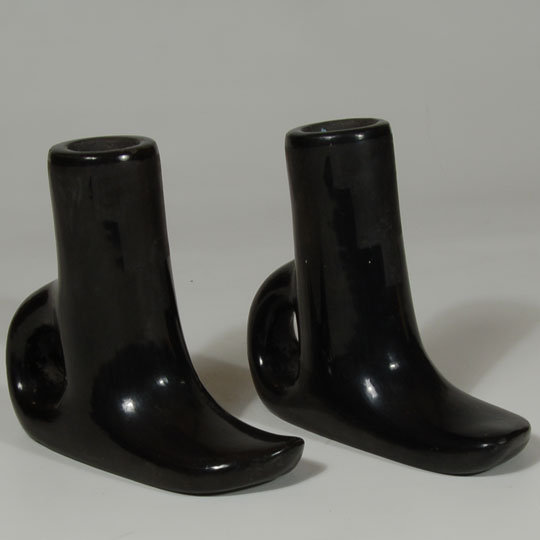 Residents of Santa Fe were enchanted with their nearby Native residents of the pueblos of Santa Clara, Tesuque and San Ildefonso. Many Santa Feans decorated their homes with functional pueblo pottery items such as candlesticks, table lamps, salt and pepper shakers, napkin holders, etc. made by those local potters. These items added a soft touch to otherwise rather sparse interiors of homes during the Great Depression of the 1930s.
Residents of Santa Fe were enchanted with their nearby Native residents of the pueblos of Santa Clara, Tesuque and San Ildefonso. Many Santa Feans decorated their homes with functional pueblo pottery items such as candlesticks, table lamps, salt and pepper shakers, napkin holders, etc. made by those local potters. These items added a soft touch to otherwise rather sparse interiors of homes during the Great Depression of the 1930s.
Santa Clara Pueblo Corn Dancer Painting by Helen Hardin Tsa-Sah-Wee-Eh - C3777o
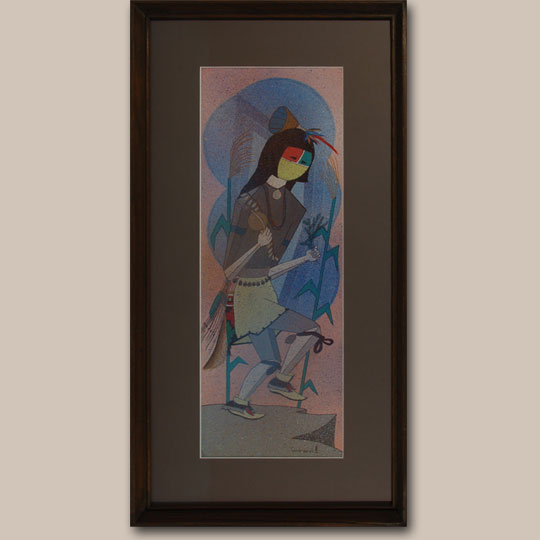 For Helen Hardin, art awards began at the early age of six when she won first prize for the best black and white pencil drawing of a fire engine. Encouraged by her mother, Helen was soon competing in Indian art competition for children. She sold her first painting at the age of nine at the Inter-tribal Indian Ceremonial at Gallup, New Mexico. During her high school years, Helen was featured in an article in the June, 1959 issue of the national magazine, "Seventeen." She competed in many student art competitions in New Mexico and designed and supervised school projects where artistic ability was needed. While in school, Helen won several local beauty contests for young Indian girls.
For Helen Hardin, art awards began at the early age of six when she won first prize for the best black and white pencil drawing of a fire engine. Encouraged by her mother, Helen was soon competing in Indian art competition for children. She sold her first painting at the age of nine at the Inter-tribal Indian Ceremonial at Gallup, New Mexico. During her high school years, Helen was featured in an article in the June, 1959 issue of the national magazine, "Seventeen." She competed in many student art competitions in New Mexico and designed and supervised school projects where artistic ability was needed. While in school, Helen won several local beauty contests for young Indian girls.
Southwest Navajo Indian Shadowbox Turquoise Pendant - C3777M
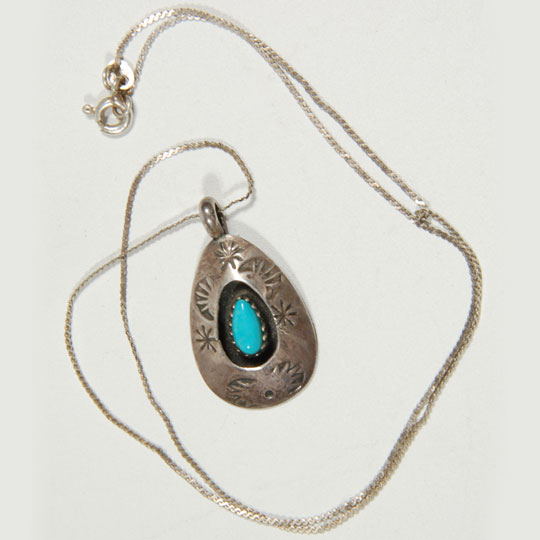 The Navajo style of highlighting the beauty of a turquoise stone is especially evident in the shadowbox style of this small pendant. The unknown artist has set a sky blue stone within a delicately stamped shadowbox.
The Navajo style of highlighting the beauty of a turquoise stone is especially evident in the shadowbox style of this small pendant. The unknown artist has set a sky blue stone within a delicately stamped shadowbox.
Zuni Apache Gaan Dancer Bolo Tie by Lambert Homer Jr. - C3777J
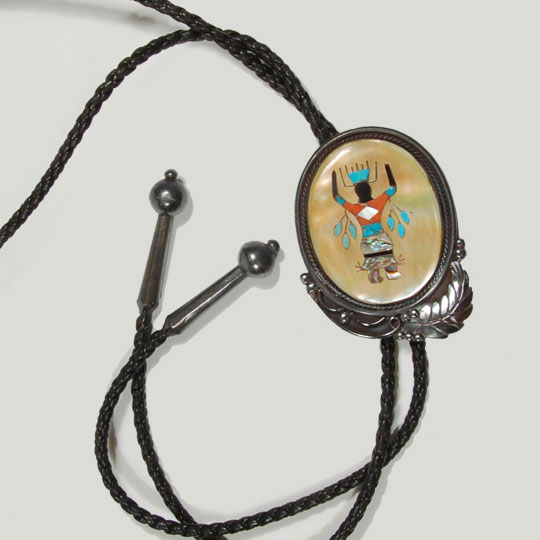 Lambert Homer Jr. was the son of well-known Zuni lapidary artist Lambert Homer and the grandson of Leekya Deyuse. Along with his father, Lambert Homer Sr., he worked for the legendary trader C. G. Wallace. Wallace became a trader at Zuni in 1920 and revitalized the jewelry making tradition at the pueblo by introducing new tools and working closely with the artists. He hired only the most talented artists and marketed their work to the tourists visiting the Southwest. The result of this endeavor was the creation of some of the most beautiful pieces of Native American jewelry made in the early 20th century. Lambert Homer Sr. is credited with being the first to incorporate the Apache Gaan Dancer as a motif.
Lambert Homer Jr. was the son of well-known Zuni lapidary artist Lambert Homer and the grandson of Leekya Deyuse. Along with his father, Lambert Homer Sr., he worked for the legendary trader C. G. Wallace. Wallace became a trader at Zuni in 1920 and revitalized the jewelry making tradition at the pueblo by introducing new tools and working closely with the artists. He hired only the most talented artists and marketed their work to the tourists visiting the Southwest. The result of this endeavor was the creation of some of the most beautiful pieces of Native American jewelry made in the early 20th century. Lambert Homer Sr. is credited with being the first to incorporate the Apache Gaan Dancer as a motif.
Zuni Pueblo Inlay Sunface Bolo by Sadie and Morris Laahte - C3777F
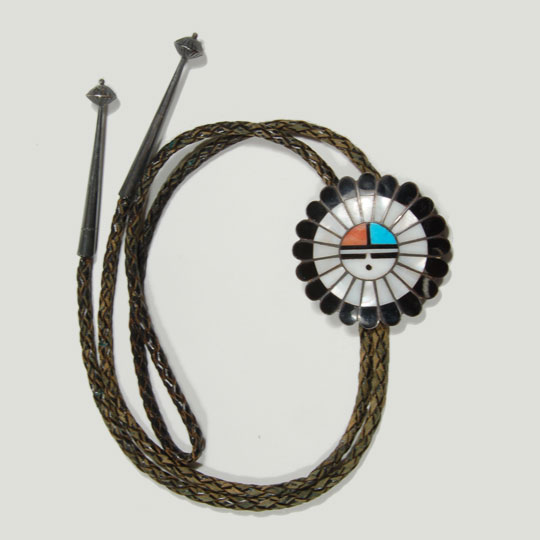 The Sunface is an important symbol for the Zuni as it represents the sun- the giver of all life. Traditionally, the Zuni have been an agricultural people and knowledge of the sun and its movements is of utmost importance. The sun is revered as the bringer of life and brings prosperity and joy to families.
The Sunface is an important symbol for the Zuni as it represents the sun- the giver of all life. Traditionally, the Zuni have been an agricultural people and knowledge of the sun and its movements is of utmost importance. The sun is revered as the bringer of life and brings prosperity and joy to families.
This jewelry piece was made by Zuni Artists Sadie and Morris Laahte. They are a husband-wife team that are known for their precise mosaic inlay work. One of their favorite designs is the Sunface. Here, they have created a beautiful Sunface using perfectly cut and placed pieces of jet, mother of pearl, coral and turquoise. It has been set as a bola tie and has handmade sterling silver tips at each end.
Zuni Pueblo Inlay Sunface Ring - C3777L
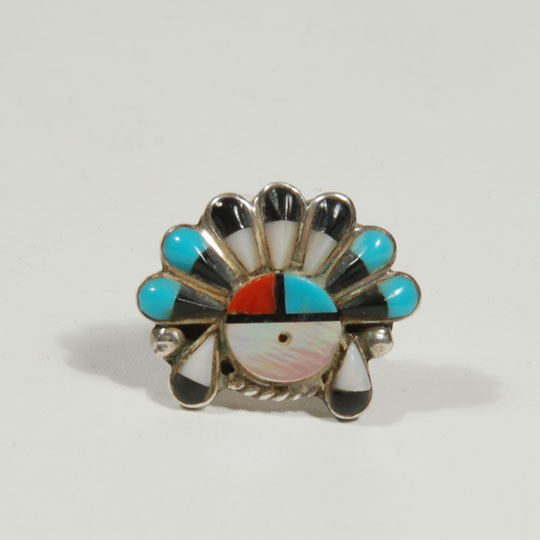 A symbol of joy and prosperity, the Zuni Sunface is a delightful motif used frequently by the Zuni. This well made little ring is comprised of expertly cut pieces of turquoise, mother of pearl, jet and coral. The stones are set within silver bezels. It is unsigned.
A symbol of joy and prosperity, the Zuni Sunface is a delightful motif used frequently by the Zuni. This well made little ring is comprised of expertly cut pieces of turquoise, mother of pearl, jet and coral. The stones are set within silver bezels. It is unsigned.
Hopi Pueblo Cottonwood Sio Hemis Katsina Doll - C3784C
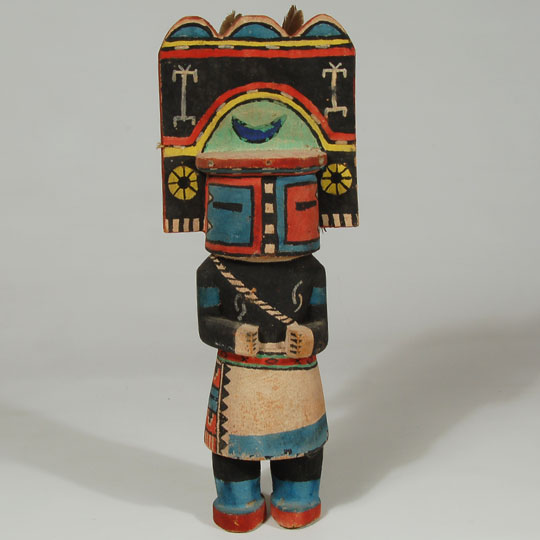 The Hemis and Sio Hemis Katsinas are probably the most beautiful and best known of all Hopi Katsinas. Their elaborate headdress, called a tableta, is partly responsible for their attraction. They both wear a kilt, and around the waist a Hopi embroidered sash.
The Hemis and Sio Hemis Katsinas are probably the most beautiful and best known of all Hopi Katsinas. Their elaborate headdress, called a tableta, is partly responsible for their attraction. They both wear a kilt, and around the waist a Hopi embroidered sash.
The Sio Hemis Katsina is an import at Hopi from Zuni Pueblo, probably in the 1890s. He may substitute for the traditional Hopi Hemis during the Niman Ceremony of mid-July. There is very little difference between the Hemis and Sio Hemis except for the decoration of the tableta. The Hopi Hemis has towering clouds and rain depicted on the tableta, while the Sio Hemis has dragonflies and sunflowers with smaller clouds at the top.
Historic Ohkay Owingeh (San Juan) Pueblo Tall Black on Gray Water Jar - C3783E
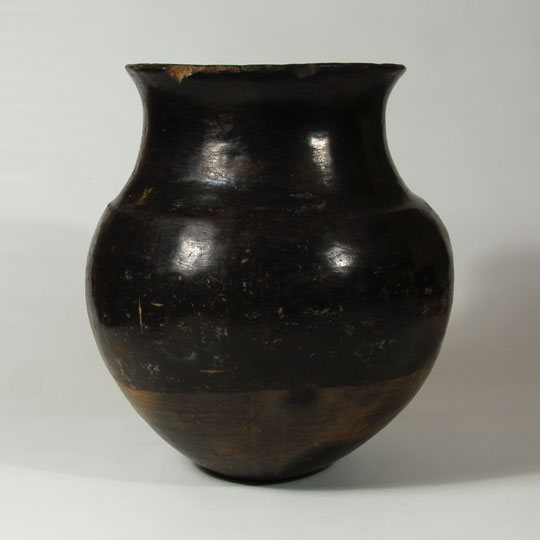 This is a traditional San Juan Pueblo olla or water jar with a polished black upper body and polished gray underbody, a style which has been made for centuries. In these jars, the red slip is wiped over the upper two-thirds of the vessel body and the lower one-third left without slip. Both upper and lower portions are then stone polished. When reduction fired, the red changes to black and the tan underbody changes to gray. The interior of the neck is matte finish. It probably dates to circa 1890-1910 period.
This is a traditional San Juan Pueblo olla or water jar with a polished black upper body and polished gray underbody, a style which has been made for centuries. In these jars, the red slip is wiped over the upper two-thirds of the vessel body and the lower one-third left without slip. Both upper and lower portions are then stone polished. When reduction fired, the red changes to black and the tan underbody changes to gray. The interior of the neck is matte finish. It probably dates to circa 1890-1910 period.
Very Large Cochiti Pueblo Pottery Dough Bowl by Elizabeth Trujillo - C3778
 Large pottery vessels are not often seen coming from potters at Cochiti Pueblo. It has not been a tradition at Cochiti for the last hundred or more years. It is quite likely that Cochiti families purchased from or traded with potters at Santo Domingo when in need of large vessels. Cochiti was quite well known in the late 1800s for making wonderful figurine pottery in the form of humans and animals, then in the 1970s, and forward, the potters became famous for making pottery storyteller figurines.
Large pottery vessels are not often seen coming from potters at Cochiti Pueblo. It has not been a tradition at Cochiti for the last hundred or more years. It is quite likely that Cochiti families purchased from or traded with potters at Santo Domingo when in need of large vessels. Cochiti was quite well known in the late 1800s for making wonderful figurine pottery in the form of humans and animals, then in the 1970s, and forward, the potters became famous for making pottery storyteller figurines.
Hopi Pueblo Wakas Koyemsi Impersonating a Cow Katsina - C3784A
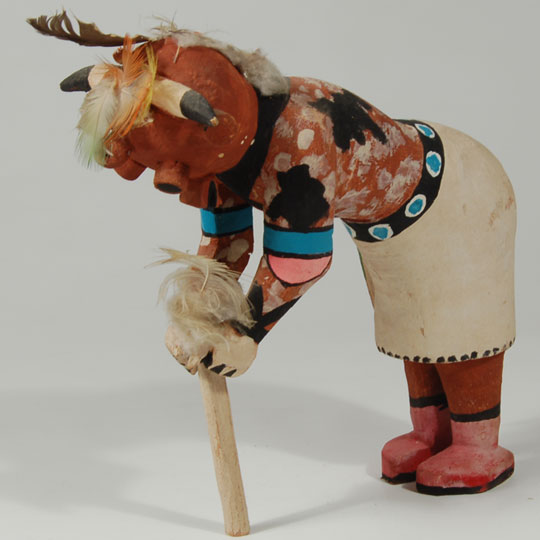 This personage has been known by several names-Mudhead, Koyemsi, Clown, Tachukti, and has been referred to as a Katsina. Barton Wright states that it is not considered a Katsina at Hopi and that Mudhead and Koyemsi are both nicknames and that Tachukti is the correct name but that he is not a clown in the sense we normally consider a clown. It will, however, always be called a Mudhead as that name has existed for a hundred years already and is not likely to go away.
This personage has been known by several names-Mudhead, Koyemsi, Clown, Tachukti, and has been referred to as a Katsina. Barton Wright states that it is not considered a Katsina at Hopi and that Mudhead and Koyemsi are both nicknames and that Tachukti is the correct name but that he is not a clown in the sense we normally consider a clown. It will, however, always be called a Mudhead as that name has existed for a hundred years already and is not likely to go away.
Polychrome Kewa - Santo Domingo Pueblo Flower Pot Jar - C3753.68
 This is a marvelous jar that is traditional in every way except for the vessel shape. It was probably made circa 1930 and exhibits the classic traits of late Santo Domingo Polychrome. The neck interior is red-slipped and stone polished. It has a black rim top. The under body is stone-polished bare paste. The cream/off-white is rag-wiped bentonite slip with black and red vegetal designs. The off-white slip extends almost completely to the bottom of the vessel. There is the customary red band that was wiped on over a portion of the red underbody. There are double framing lines at the top and bottom of the design area. Both pairs have ceremonial breaks.
This is a marvelous jar that is traditional in every way except for the vessel shape. It was probably made circa 1930 and exhibits the classic traits of late Santo Domingo Polychrome. The neck interior is red-slipped and stone polished. It has a black rim top. The under body is stone-polished bare paste. The cream/off-white is rag-wiped bentonite slip with black and red vegetal designs. The off-white slip extends almost completely to the bottom of the vessel. There is the customary red band that was wiped on over a portion of the red underbody. There are double framing lines at the top and bottom of the design area. Both pairs have ceremonial breaks.
Hopi Pueblo Black-on-red Small Tile with Palhikmana Image - C3776S
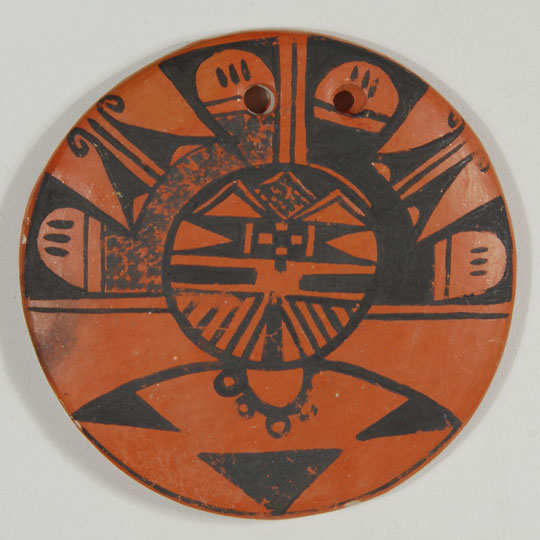 This exquisite round Hopi tile executed in black pigment on red clay features the image of the Palhikmana Katsina with her elaborate headdress. It has a pair of holes at the top so that it could be worn as a pendant or hung on a wall. It is not signed with the name of the potter.
This exquisite round Hopi tile executed in black pigment on red clay features the image of the Palhikmana Katsina with her elaborate headdress. It has a pair of holes at the top so that it could be worn as a pendant or hung on a wall. It is not signed with the name of the potter.
Hopi Pueblo Polychrome Tile with Moth Design - C3776T
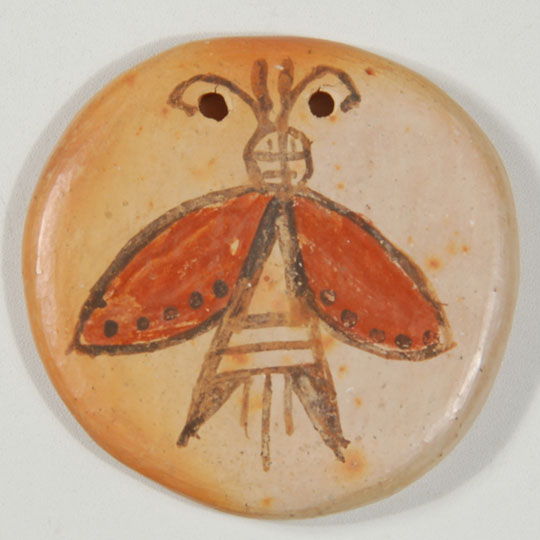 This small Hopi pottery tile is designed with a moth typical of that used by Hopi potter Grace Chapella, however, it is not signed so we do not attribute it to any specific potter. It has a pair of holes at the top to facilitate wearing it as a pendant or hanging it on a wall.
This small Hopi pottery tile is designed with a moth typical of that used by Hopi potter Grace Chapella, however, it is not signed so we do not attribute it to any specific potter. It has a pair of holes at the top to facilitate wearing it as a pendant or hanging it on a wall.
Historic Laguna Pueblo Double Headed Bird Effigy Jar - C3776C
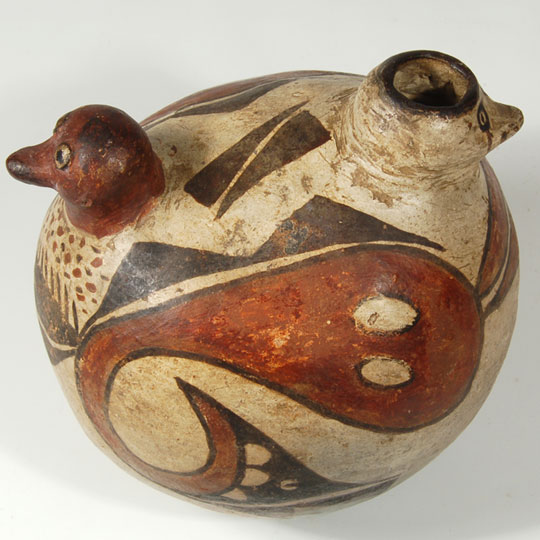 It is often difficult to make a determination of origin of Laguna Pueblo pottery because it is so closely similar to that from Acoma, for good reason. Laguna is, relatively speaking, a recent pueblo, having been established in 1699, although Laguna people say that the pueblo was previously occupied as early as circa 1400, however, the current villages date to 1699. Residents of Acoma, Zia, Zuni and other pueblos jointly settled the new pueblo. Because of its close proximity to Acoma, the pottery from Laguna resembles that of its neighbor. The same clay, same temper, and similar designs predominate between the two pueblos.
It is often difficult to make a determination of origin of Laguna Pueblo pottery because it is so closely similar to that from Acoma, for good reason. Laguna is, relatively speaking, a recent pueblo, having been established in 1699, although Laguna people say that the pueblo was previously occupied as early as circa 1400, however, the current villages date to 1699. Residents of Acoma, Zia, Zuni and other pueblos jointly settled the new pueblo. Because of its close proximity to Acoma, the pottery from Laguna resembles that of its neighbor. The same clay, same temper, and similar designs predominate between the two pueblos.
Zia Pueblo Pottery Tile with Floral Design by Benina Medina - C3776R
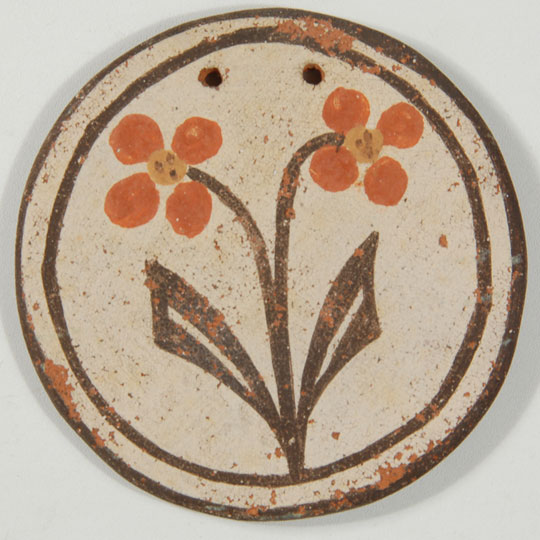 This floral design Zia Pueblo pottery tile has a paper label attached to the back that has the name Benina Medina written on it, presumably the name of the potter. According to her granddaughter, Reyes Madalena, Benina Medina was born at Zia Pueblo in 1873. She married Ramon Madalena from Jemez Pueblo in the late 1890s. She was an accomplished potter having won prizes at Santa Fe's Indian Market in the 1920's. After moving to her husband's pueblo, she was instrumental in reintroducing a pottery making tradition to Jemez Pueblo.
This floral design Zia Pueblo pottery tile has a paper label attached to the back that has the name Benina Medina written on it, presumably the name of the potter. According to her granddaughter, Reyes Madalena, Benina Medina was born at Zia Pueblo in 1873. She married Ramon Madalena from Jemez Pueblo in the late 1890s. She was an accomplished potter having won prizes at Santa Fe's Indian Market in the 1920's. After moving to her husband's pueblo, she was instrumental in reintroducing a pottery making tradition to Jemez Pueblo.
Hopi Tawaquaptewa Katsina Carving by Wilson Tawaquaptewa - C3753.65
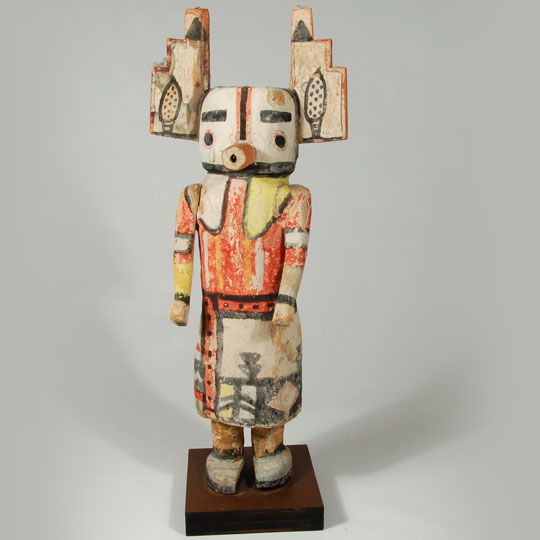 There was a time at Hopi when there were concerns by some of the older generation about making katsina dolls for sale to non-Indians. Yet, the allure of the financial aspect of selling them was appealing. To overcome this dilemma, a Hopi elder named Wilson Tawaquaptewa solved the concern for himself by making katsina dolls that were not true representations of Hopi Katsinas.
There was a time at Hopi when there were concerns by some of the older generation about making katsina dolls for sale to non-Indians. Yet, the allure of the financial aspect of selling them was appealing. To overcome this dilemma, a Hopi elder named Wilson Tawaquaptewa solved the concern for himself by making katsina dolls that were not true representations of Hopi Katsinas.

